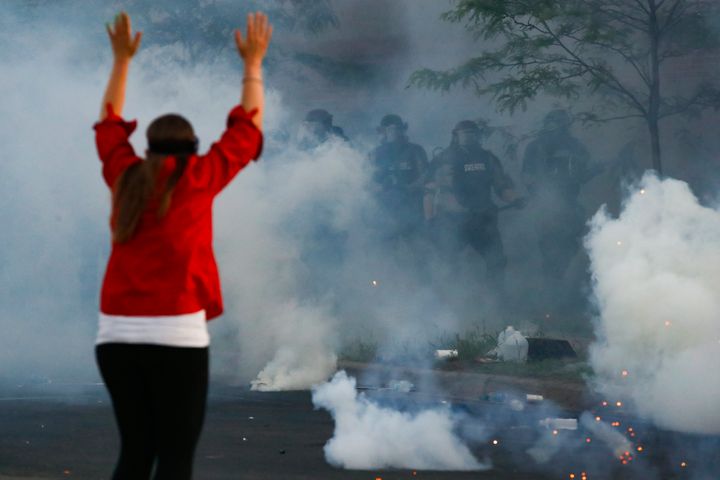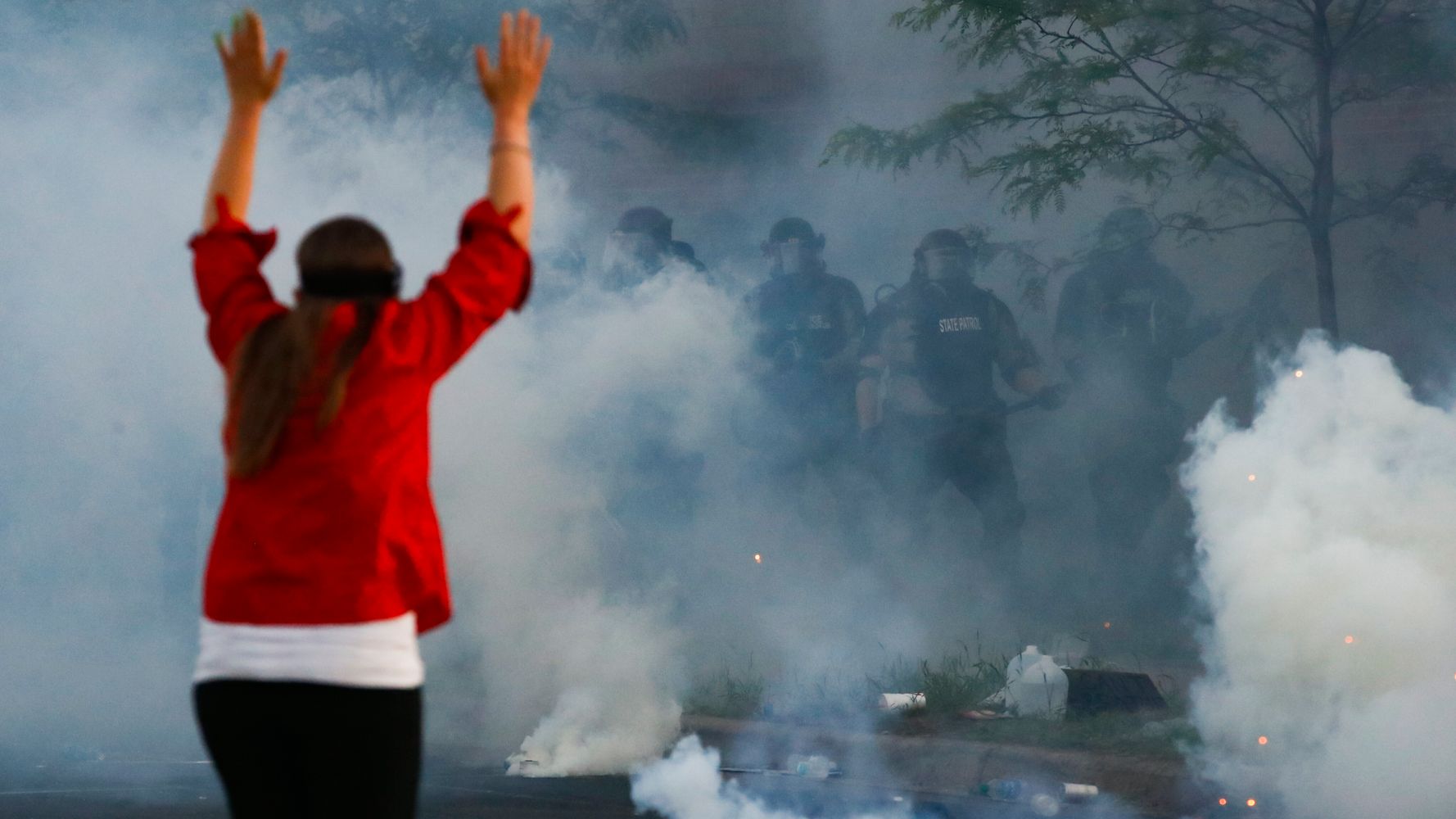[ad_1]
Police across America are deploying pepper spray and tear gas against demonstrators seeking justice for Black victims of police violence, such as George Floyd, who died in Minneapolis while a white officer pressed on his neck and ignored his pleas that he could not breathe.
If you go to a protest, you need to prepare for a hostile environment. Some law enforcement officials have responded to protests with violence by charging into crowds, assaulting and arresting peaceful protesters. On Monday, federal police in riot gear used gas and flash-bangs to disperse a peaceful crowd of protesters near the White House, just so President Donald Trump could walk to a nearby church for a photo-op.
To avoid panicking in the moment, you should plan what to do if you or the people around you are exposed to chemical irritants that make you temporarily unable to function. While tear gas and pepper spray are chemically different, the best remedy for both is to flush it out of your eyes with water, and to get the chemicals out of your environment, according to Dr. Diane Calello, executive and medical director of the New Jersey Poison Center and an associate professor of emergency medicine at Rutgers New Jersey Medical School.
But there’s plenty more you need to know.
What is pepper spray?
Pepper spray, also known as oleoresin capsicum, is a combination of chile extracts. Although pepper spray is widely available for purchase, the kind you are likely to face at a protest is a much more concentrated dose of capsaicin, the active ingredient in oleoresin capsicum.
“The pepper spray we can buy as citizens of the United States has a much lower concentration than the pepper spray used by law enforcement,” said Dr. Kelly Johnson-Arbor, co-medical director of the National Capital Poison Center.
Tear gas and pepper spray both cause intense burning and irritation of the eyes, nose, mouth, respiratory system and skin, Johnson-Arbor said.
“The very best thing to do if chemical weapons are being used is to stay calm and spread calm.”
– Chicago Action Medical street medic
If you’re exposed to pepper spray, get to high ground and flush it out with as much water as you need.
“The very best thing to do if chemical weapons are being used is to stay calm and spread calm,” said Ben, a nursing student and a street medic with Chicago Action Medical, a group that provides health support to justice movements. Ben wanted to be identified only by first name for fear of reprisal.
If you are exposed to pepper spray, don’t lie down. Pepper spray is heavier than air and will sink toward the ground, so “exposures will be higher there,” said Johnson-Arbor.
If you’re planning ahead, it’s helpful to bring a change of clothes if you are hit by pepper spray. But first, go to a safe area. “First and foremost, get out of the area, get out of the clothes and get clean, including your face and your hair and your hands and anything that may have the spray on it,” Calello said. Water and soap is all you need for your face and body.
Ben said that flushing your eyes with a forceful stream of water is the best treatment ― he recommends using a 24-ounce water bottle dedicated solely to eye flushes ― but to be mindful of what’s already in your eyes before starting an eye flush. In order to safely and effectively flush your eyes, you cannot be wearing contact lenses.
“Ideally, folks should wear glasses rather than contacts to protests and direct actions,” Ben said.

Rinsing your eyes under running shower water can be helpful, too, Johnson-Arbor said, and Calello noted getting rid of all the pepper spray is likely to take more than a small bottle of water unless you’re exposed to only a little bit. “It’s basically running under a faucet until it feels better,” she said, adding that in the ER, “we run liters of water, potentially, into [a patient’s] eyes until they are feeling better and we feel like the chemical is out.”
You may see milk being used to combat pepper spray, but it’s not really recommended. “Will it hurt to pour milk into your eyes instead of water? No, it won’t, but it probably does not have any benefit over water or saline irrigation,” Calello said.
“Beyond the eye flush, encourage someone who’s been exposed to these irritants to spit and blow their nose,” Ben said. “Our goal is to get rid of whatever is causing us pain.”
Keep in mind that we’re in the middle of a coronavirus pandemic, so avoid coughing, spitting or sneezing on others, and wear a face covering whenever possible.
What is tear gas, and what does it do?
The most common type of tear gas used currently is “CS,” or o-chlorobenzylidene malonitrile, said Johnson-Arbor.
According to the Centers for Disease Control and Prevention, common symptoms of exposure to a riot control agent like tear gas include excessive tearing of the eyes, blurred vision, nose swelling, difficulty swallowing, chest tightness, a choking sensation, wheezing, skin rashes, nausea and vomiting.
You will start feeling some of these side effects within 20 to 30 seconds of being hit, Calello said. Although the effects are generally short-lived once the exposure is over, permanent damage and even deaths have been reported.
Water is the recommended remedy for tear gas, too.
When you are exposed to tear gas, it’s important to stay calm and breathe slowly through the discomfort. “Panicking increases the irritation,” states Amnesty International.
There is no specific antidote to tear gas. “It is a chemical that directly stimulates the pain nerves in your eyes, causing them to develop very painful tearing, lid spasm, burning,” Calello said. “There is not an antidote other than just washing [your eyes] out and getting it out of there.”
Although there are many proposed treatments, including milk and baby shampoo, Johnson-Arbor recommends sticking with water because baby shampoo and milk have not been proved to be more effective, and water is more widely available. One 2018 study published in the Western Journal of Emergency Medicine found that irrigating people’s skin and eyes with water and baby shampoo provided no better relief from tear gas or pepper spray than water alone.
As with treating pepper spray, using large quantities of water to flush out the parts of your body that got exposed is the best remedy.
Once people are no longer exposed and in fresh air, the symptoms of tear gas exposure should resolve within minutes to an hour, Johnson-Arbor said.
Take care of yourself after being tear-gassed or pepper-sprayed.
Do pay attention to lingering symptoms from chemical irritants. If you are having any trouble breathing, especially if you are asthmatic, seek out medical attention, medical experts said.
Pay attention to your mental care, too. “If you are involved in a very traumatic event that involves the use of tear gas, you may find that you are fatigued or feel stressed from the encounter, and being conscious of that is a potential target of self-care,” Calello said.
Ben’s aftercare tips include changing clothes as soon as possible and immediately putting them in a plastic bag until they can be laundered with detergent-based soap. Then showering with cool water.
“Make sure that you are drinking plenty of water,” Ben said. “Importantly, take care of yourself emotionally. Debrief with a buddy!”
[ad_2]
Source link

